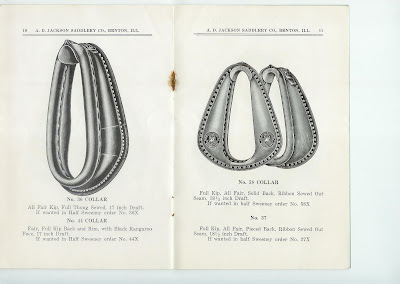I recently acquired a bunch of printing blocks from a local Paducah resident. They are from a harness business that closed in the 1950's. Although I now live in Kentucky horse country, I have no clue as to the particulars of horse business.... The blocks were used to produce catalogs similar to the one pictured above. I was able to find information online on one of the suppliers, A.D. Jackson Saddlery, as the block, very similar to the horse collar in the above catalog has a stamp with that name on it. Fred B. McAfoos & Co. has a nice historical page which describes how the family business evolved. Today, they sell lawnmowers and outdoor power tools.
Fred B McAfoos opened his business in
I listed the blocks I could identify on Etsy, but am stumped on several others. I love old things in general, but I find these blocks especially interesting and would like to get more of them if I can move the ones I got. Etsy's search system is made up of tags that describe the item, so it's important that I use the right words to describe these blocks. I imagine they will be of special interest to anyone who loves horses, Western and Southern history, and printing techniques. The blocks are still in decent shape and can be used on both paper and fabric using a brayer and inks. Maybe someday I'll have the time to play with them and see what happens.
Meanwhile, if you know what the correct names for the items below, it would be a great help to me. Leave a description in the comment section referring to the item by number. The more specific the description, the better. We have 14 keywords to use per item on Etsy, so if a horse harness has a certain function, then it would be good to know that. In my ignorance, I imagine there are items that might be for show while others for work and that there are distinctions by type as in English and Western saddles.













It would help if you made prints of these so we could see them right-ways. Anyway, not 100% sure on #1 but it may be a back strap and tie down- the tie down is to the right and connects to the chin strap of the bridle at the top and the girth at the bottom and keeps the horse from throwing it's head; #2 is a headstall (part of a bridle). The loop to the left is the browband. #3 will have to be printed, I can't tell but it may be an overcheck bridle that is used to keep a horse's head properly positioned. #4 may be a breast plate or it could be a belly band; I've just never seen them with clips instead of buckles; #5 is a bridle and reins with blinkers to keep the horse from seeing to the sides or behind it. #6 is a crupper, it goes under the horse's tail and keeps the harness from sliding forward. #7 may be tugs- they attach from the collar to whatever is being pulled. I think #8 is a front view of the harness with back- and belly-band showing the rings the reins go through- the things hanging down on either side are what the shafts go through.
ReplyDeleteNot 100% on all but I think I am pretty close. I never had driving or pulling horses but had lots of friends who did.
teri